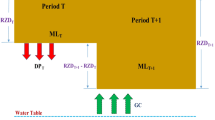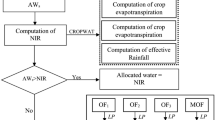Abstract
Water is needed in all aspects of life and is vital to its social, economical and environmental dimensions. Having a key role in sustainable development, water management requires an integrated approach.
Irrigation Water shortage promotes the development of innovative management and supply enhancement models. Effective water management requires a comprehensive consideration of all related aspects, e.g., technical, social, environmental, institutional, political and financial. Then the conventional methods of cost-benefit analysis and single-objective models have changed to multi-objective models.
The rising of population in Iran puts significant pressure on authorities and infrastructures to provide water. Without improvement in water management, Irrigation demand will continue to increase, water supplies will diminish and the population pressure will decay infrastructure.
This paper describes compromise programming to solve multi-criteria decision making in irrigation planning for Polrud project in the North of Iran. The important objectives of project are: regulation of reliable water at the demand time, improving rice and tea production, domestic water supply, environmental needs as well as reducing social conflicts. After execution of the model, results show the optimum decision for crops pattern and extents of allocated water to each area. This study is a successful implementation of IWRM in irrigation planning.
Similar content being viewed by others
References
Abrishamchi, A. and Tajrishi, M.: 1997, ‘Multi-criteria decision making in irrigation planning,’ 4th International Conference on Civil Engineering, Sharif University of Technology, Tehran.
Bender, M. J. and Simonovic, S. P.: 2000, ‘A fuzzy compromise approach to water resource systems planning under uncertainty,’ Fuzzy Sets and Systems 115, 35–44.
Brooke, A., et al., 1998, GAMS: General Algebraic Modeling System. GAMS Development Corporation, Washington DC.
Doorenbos, J. and Kassam, A. H.: 1979, ‘Yield Response to Water,’ FAO Irrigation and Drainage, paper No. 33, Food and Agriculture Organization, Rome.
Duckstein S. and Opricovic, S.: 1980, ‘Multi-objective optimization in river basin development,’ Water Resources Research 16, 14–20.
Mahab Ghodss Consulting Engineers: 2001, Water Resources Planning and Economic Study of Polrud Project. (In Farsi).
Opricovic, S. and Tzeng, G. H.: 2003, ‘Defuzzification within a multi-criteria decision model,’ International Journal of Uncertainty, Fuzziness and Knowledge-Based Systems 11(5), 635–652.
Psilovikos, A. and Tzimopoulos, T.: 2004, ‘Comparison of quadratic and non-linear programming (QP and NLP) optimization models in groundwater management,’ Journal of Hydroinformatics 6(3), 175–185, IWA Publishing.
Saaty, T. L.: 1980, The Analytical Hierarchy Process, Planning, Priority, Resource Allocation RWS.
Sahoo, G. B. Loof, R. Abernethy, C. L., and Kazama, S.: 2001, ‘Reservoir Release Policy for Large Irrigation System,’ Journal of Irrigation and Drainage Engineering, ASCE 127(5), 302–310.
Simonovic, S. P.: 1989, ‘Application of water resources systems concept to the formulation of a water master plan,’ Water International 14(1) 37–50.
Simonovic, S. P.: 2002 ‘A Spatial Fuzzy Compromise Programming for Management of Natural Disasters,’ The Institute for Catastrophic Loss Reduction (ICLR), Ontario, Canada.
Szidarovsky, F., Gershon, M. E., and Duckstein, L.: 1986, Techniques for Multi-Objective Decision-Making in Systems Management Elsevier, Amsterdam, The Netherlands.
Tkach, R. J. and Simonovic, S.: 1997 ‘A new approach to multi-criteria decision making in water resources,’ J. Geographical Information and Decision Analysis 1(1), 25–43.
Zarghaami, R., Abrishamchi, A., Ardakanian, R.: 2005, ‘Multi-criteria decision making for integrated urban water management,’ Proceedings of Symposium S2 held During the Seventh IAHS Scientific Assembly, Foz do Iguaçu, Brazil, April 2005. IAHS Publ. 293.
Zeleny, M.: 1973, ‘Compromise programming, multiple criteria decision-making,’ in J. L. Cochrane and M. zeleny (eds), Multiple Criteria Decision Making, 263–301. University of South Carolina Press, Columbia, USA.
Author information
Authors and Affiliations
Corresponding author
Rights and permissions
About this article
Cite this article
Zarghaami, M. Integrated Water Resources Management in Polrud Irrigation System. Water Resour Manage 20, 215–225 (2006). https://doi.org/10.1007/s11269-006-8048-0
Received:
Accepted:
Issue Date:
DOI: https://doi.org/10.1007/s11269-006-8048-0




